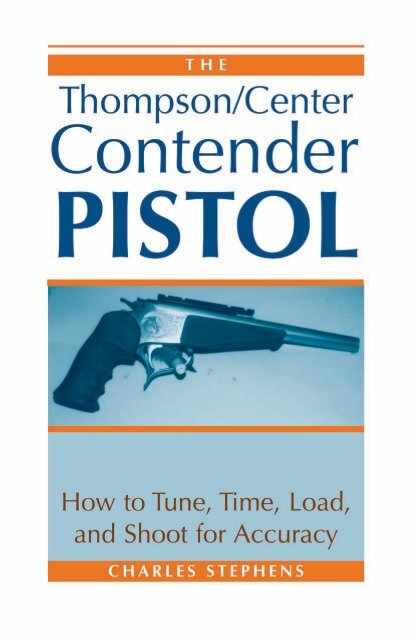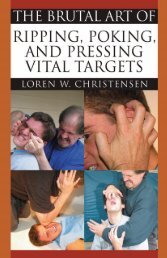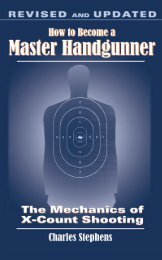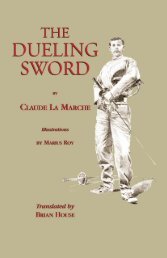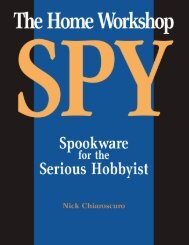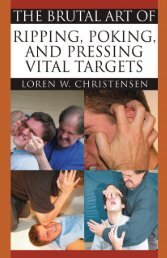Thompson/Center Contender Pistol: Hoe to Tune, Time, Load, and ...
Thompson/Center Contender Pistol: Hoe to Tune, Time, Load, and ...
Thompson/Center Contender Pistol: Hoe to Tune, Time, Load, and ...
Create successful ePaper yourself
Turn your PDF publications into a flip-book with our unique Google optimized e-Paper software.
contentsIntroduction 11 The <strong>Contender</strong> <strong>Pis<strong>to</strong>l</strong>—Parts <strong>and</strong> Prices 92 Tuning <strong>and</strong> Timing 193 Care <strong>and</strong> Maintenance 254 Shooting the <strong>Contender</strong> 315 Accuracy <strong>and</strong> Performance 37Appendix 49III
chaptertwoTuning <strong>and</strong> TimingAlmost every new pis<strong>to</strong>l I have purchased in the past20 years has required some h<strong>and</strong> work, known in theworld of gunsmiths as tuning <strong>and</strong> timing, <strong>to</strong> enable me <strong>to</strong>shoot it accurately. Some of these pis<strong>to</strong>ls would shoot aspecific lot of ammunition or a certain h<strong>and</strong>load veryaccurately without any individual h<strong>and</strong> work. However,for the same firearm <strong>to</strong> shoot most any ammunition or allgood h<strong>and</strong>loads accurately, some tuning <strong>and</strong> timing wererequired. The <strong>Contender</strong> pis<strong>to</strong>ls I have purchased are noexceptions.Tuning the <strong>Contender</strong> <strong>to</strong> extract <strong>to</strong>p accuracy from itrequires a trigger job. Two surfaces of metal, one oneach of two different parts of the trigger group, requirepolishing before a shootable trigger pull can be obtained.Of course, there are always exceptions <strong>to</strong> this polishingprocedure, one alternative being <strong>to</strong> have the two partshard chrome-plated.Jim Ishmael does a fine job of chrome-plating thestriker <strong>and</strong> the striker notch area of the trigger. I have19
Tuning <strong>and</strong> Timingadjustments <strong>to</strong> the <strong>Contender</strong>. First, adjust the amoun<strong>to</strong>f trigger/striker engagement by turning the triggerspring tension screw (part # 36-3) shown in the previouschapter on page 12.Do this adjustment by first opening the action <strong>and</strong>making sure the chamber is empty <strong>and</strong> the firearm hasbeen rendered safe. Remove any cartridges now, if yourfirearm is loaded. Only after you have emptied thechamber <strong>and</strong> placed the hammer safety in the safe, centerposition, should you close the action <strong>and</strong> cock thehammer. Using a trigger weight scale, pull the trigger<strong>and</strong> observe the pull weight on your scale.You are now ready <strong>to</strong> make an adjustment <strong>to</strong> the trigger-springtension screw. With the frame held upsidedown so that you can observe the screw, use the propersize Allen wrench <strong>and</strong> turn the screw clockwise until thehammer falls safely <strong>and</strong> harmlessly on its safety mechanism.Now turn the screw counterclockwise just adegree or so. Turning the screw counterclockwise willincrease the trigger pull weight so that the hammer willremain cocked when it is returned <strong>to</strong> the rear position inthe frame. After this first adjustment, check the pullweight on the scale again. You may have <strong>to</strong> try severalsmall adjustments before you achieve the pull weightyou desire. A safe, trigger pull weight of between 32 <strong>and</strong>64 ounces (2 <strong>and</strong> 4 pounds) may be obtained by adjustingthis trigger spring tension screw, or a combination ofadjusting it <strong>and</strong> clipping a coil from its length.When clipping the coil spring, you should clip a quarterof a turn at a time until the desired pull weight isobtained. Clipping <strong>to</strong>o much coil at one time can resultin inadequate contact between the trigger <strong>and</strong> strikersurfaces at full cock, <strong>and</strong> also inadequate trigger returneach time the trigger is pulled. If this occurs, you mustreplace the spring with a new one.Older model <strong>Contender</strong> pis<strong>to</strong>ls had a very tightly21
The <strong>Thompson</strong>/<strong>Center</strong> <strong>Contender</strong> <strong>Pis<strong>to</strong>l</strong>wound <strong>and</strong> stiff spring when new. It is next <strong>to</strong> impossible<strong>to</strong> clip this old-model trigger spring. If the desiredtrigger pull weight cannot be obtained by polishing thetrigger/striker engagement areas <strong>and</strong> adjusting thetrigger return spring, then the trigger return springmust be replaced with a lighter aftermarket one. If youreturn your old model frame <strong>to</strong> the <strong>Thompson</strong>/<strong>Center</strong>Arms Company, the company may replace it with oneof the new models that incorporate the latest safetymechanisms. Call the company first before you shipthem your old frame <strong>to</strong> be sure of the action you want<strong>to</strong> take. Your old frame may be worth more <strong>to</strong> the collec<strong>to</strong>rthan the price of a new one, <strong>and</strong> you may wish <strong>to</strong>advertise it or trade it in the T/C Collec<strong>to</strong>rsAssociations quarterly journal.There are other parts of the <strong>Contender</strong> that requirepolishing. I consider polishing these parts <strong>to</strong> be part ofmaintenance, as doing so will not usually improve theaccuracy of the pis<strong>to</strong>l. The next chapter covers the polishingof these parts.The best thing about timing the <strong>Contender</strong> is that youdon’t have <strong>to</strong> tune the pis<strong>to</strong>l in order <strong>to</strong> time it. Timingthe <strong>Contender</strong> is a separate procedure <strong>and</strong> is the simpler,<strong>and</strong> perhaps more neglected, of the two. Timing, asthe term is applied <strong>to</strong> h<strong>and</strong>guns, refers <strong>to</strong> the conditionof the pis<strong>to</strong>l when the hammer is cocked <strong>and</strong> the gun isready <strong>to</strong> fire. This condition should be the same eachtime the gun is fired.For revolvers <strong>and</strong> semiau<strong>to</strong> pis<strong>to</strong>ls, this condition isno more complex than for the <strong>Contender</strong>. For all threetypes of firearms, the gun must be in perfect time inorder for it <strong>to</strong> consistently fire accurately. The key wordhere is consistently. The <strong>Contender</strong> is timed by theshooter for each shot. The shooter achieves the timingby pulling the trigger guard rearward <strong>to</strong> release the bolt<strong>and</strong> open the action.22
Tuning <strong>and</strong> TimingThe amount of trigger/striker engagement is controlledby the distance the trigger guard moves as theshooter pulls it backward each time. If the shooter pullsthe trigger guard backward <strong>to</strong> a different point each time,the result will be a <strong>Contender</strong> that is out-of-time for eachshot. The trigger pull weight will then vary from shot <strong>to</strong>shot, resulting in inconsistent accuracy.The way <strong>to</strong> correctly time the <strong>Contender</strong> is <strong>to</strong> alwayspull the trigger guard back <strong>to</strong> its maximum rearwardtravel each time the action is opened. This will guaranteemaximum trigger/striker engagement for each shot,with the final result of producing consistent trigger pullweights <strong>and</strong> accuracy. The firearm will be “in time” foreach shot.23


